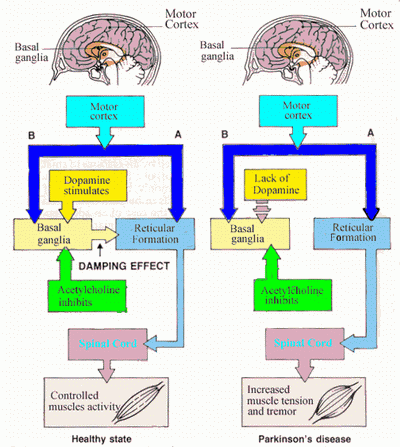Parkinson's Disease

What is it?
Parkinson's disease (PD) is a degenerative disease of the substantia nigra cells in the brain. These cells produce the neurotransmitter dopamine, which helps the basal ganglia to maintain balance, posture, and coordination.
Signs and Symptoms
Primary Symptoms
- 1. Nonspecific achiness weakness, and fatigue, PD has a slow onset and is most common in elderly people. Therefore, these early symptoms are often missed, either because they are too subtle to be seen or because of an assumption that a certain amount of fatigue and stiffness is a natural part of growing older.
- 2. Resting tremor. This phenomenon is present in most Pd patients and is often one of the first noticeable symptoms. A rhythmic shaking or pill-rolling action of the hand is often seen. Tremor may also affect the foot, head and neck. This tremor is most noticeable when the patient is at rest but not sleeping. It often disappears entirely when the patient is engaged in some other activity.
- 3. Bradykinesia: This is difficulty in initiating or sustaining movement. It can take a long time to begin a voluntary movement of the arm or leg, and the limb’s movement may be halting and interrupted midstream. Pd patients with bradykinesia sometimes report feeling rooted to the floor when they can visualize moving a leg but it doesn’t happen withoutsustained effort.
- 4. Rigidity. Gradually the muscles, particularly the flexor muscles, become permanently hypertonic. This can give rise to a characteristically stooped posture, as the trunk flexors contract more strongly than the paraspinals. This particularly obvious when PD accompanies osteoporosis, as it often does in elderly patients. Rigidity also makes it difficult to bend or straighten arm and legs and can cause a particular masklike appearance as the facial muscle lose flexibility and ease of movement. This also accounts for a reduced rate of blinking, increased drooling, and difficulty with eating, swallowing, and digestion. The rigidity that accompanies Pd is not the same thing as spasticity, which implies a different kind of nerve damage, discussed in the sections on the spinal cord injury and traumatic brain injury. Rigidity indicates massage (with caution), while spasticity, which often accompanies numbness, must be approached more carefully.
- 5. Poor postural reflexes: Disruption in the activity of basal ganglia cells results in uncoordinated movement and poor balance. PD patients are particularly susceptible to falling.
Secondary Symptoms:
- 1. Shuffling gait: Difficulty in bending arms and legs. Often the ability to swing the arm is noticeable diminished on one side.
- 2. Changes in speech: PD causes progressive rigidity of the muscles in the larynx that control vocalization. Speech gradually becomes monotone and expressionless and progresses toward whispering.
- 3. Changes in handwriting: The loss of coordination in fine motor muscles changes the ability of a PD patient to write by hand.
- 4. Sleep disorder: PDd patients are subject to a variety of sleep disorders, from a complete reversal of normal sleeping schedules to sleeplessness because it is difficult or impossible to move in bed.
- 5. Depression: Can be related to insomnia, or it can be a side effect of medication.
- 6. Mental degeneration: This is a subject of some controversy. Some sources suggest that advanced PD patients have memory loss and deterioration of thought processes.
What happens?
PD is one of a variety of movement disorders. It involves changes in the CNS structures that cause them to work inefficiently. To discuss this condition thoroughly it is necessary to review some of the inner workings of the brain.
How is it recognized?
Early symptoms of PD include general stiffness and fatigue: resting tremor of the hand, foot, or head: and slowed movement. Later symptoms include poor balance a shuffling gait, a masklike appearance to the face and a monot. voice.
Is massage indicated or contraindicated?
PD indicates massage with caution. Care must be taken for the physical safety of these clients, who cannot move freely smoothly.
Pd patients have progressive stiffness and rigidity of voluntary muscles. Massage can be a valuable tool not only to maintain flexibility and range of motion but also to reduce anxiety and depression. It is important to work in cooperation with the client’s primary physician, because massage may affect the need for some kind of medication. Pd patients receive tremendous benefits from various types of massages: frequent treatments with short duration seem to be most effective.
Very effective Massage Modalities are:
Deep Tissue Massage: Supportive with adaptations for client comfort.
Lymphatic Drainage: Supportive
PNF/MET/Stretching: Supportive
Reflexology: Indicated: work brain, spine all glands, solar plexus points
Shiatsu: Supportive: Treat BL, K, GB, SP, LV, SI Meridians and extensions
Swedish massage: Indicated: help with sleep /rigidity
Trigger points Therapy: Indicated in all stages



